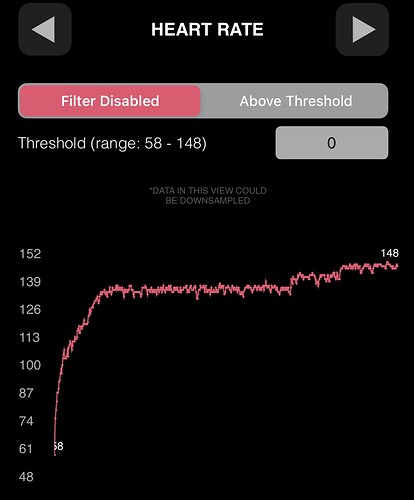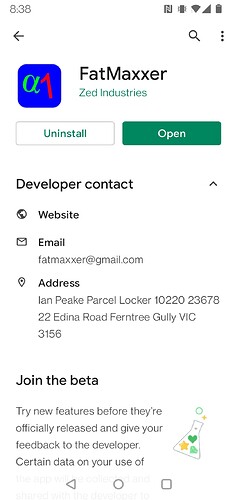Unfortunately I never kept any of the HRV Data Logger files. It wouldn’t be hard to do another session next time I ride indoors.
You know you can record rr times with a Garmin. Just make sure the heart rate strap is paired over blue and not over ant. Ant drops more packets so there are more artifacts and alpha 1 is very sensitive to that. (Also why a watch on your wrist may have issues recording the data as when you swing your arm and line of sight gets broken between watch and hr strap there may be artifacts but I’m not sure on that)
https://www8.garmin.com/manuals/webhelp/edge530/EN-US/GUID-5BF2156B-9740-47F1-A564-FA22D55FDEB1.html
That would be easier if the HRV data logger app showed actual time DFA a1 rather than every 2 minutes, but I can also see how that would work and something I do when using the app outside on my easy rides. I don’t do this on the trainer as the workouts all end to be power orientated, but I guess would be simple enough to change in the workout builder from % FTP to %HR at fTP to %HR Max
One can set the data logger to every 30 seconds.
It might be interesting to try this outside to see if I see a difference. Once one has honed in on their aerobic threshold HR, I don’t see the point in running the app for every training session.
For three years I’ve been going by Seilers 60-70% recommendation and San Millan’s talk test and both were mostly right on the money confirmed by DFA a1. I feel like I’ve triangulated the aerobic threshold well enough for training by HR.
Hi Steve I wonder why you think that HR might work better? While the actual stressor is power? Don’t you want it correlated to the stress not the response? In other words, if you correlate DFA a1 to HR you are quite possibly confounding the measure because they are responses to the Power requirement stressor.
I’ll try this (setting the data logger to 30 seconds) on my next few rides which are commutes to work and ones traditionally I do in Seiler zone 1
There’s an Android App which shows Alpha1 in real-time using 2 minute windows but every 5 secs which is the recommended protocol. It’s called Fatmaxxer. The data can be subsequently saved as a CSV file. Bruce Rodgers has shown that the results are very close to Kubios.
if you intend to use DFA a1 you sort of need a 2 minute window of RR data. It has been explored in literature and found that the 2 minute window is closer to optimal. For the use case where you are using it for aerobic threshold you need clean data, which means rejecting artifacts. So that is why there is a special option in HRV logger for workout. So you will get data on a 390 second window but it is not likely to be good data. Also if you hope to get something out of DFA a1 then you probably want to use the optimal settings. The problem with logger is that they do not do the rolling 2 minute window. Their reason was it was a beta add on and they are going to fix that in a future update. Hopefully that will happen soon. So for now HRV logger is only useful for after activity analysis, the 2 minute updates are not optimal in any way. Though I have never tried it I wonder if it is reasonable to run 2 Android app simultaneous, ie trainer control and fat maxer? something I might try but for now I am hoping that Marco and team update HRV logger really soon.
The polarH10 has 2 Bluetooth channels so you can do it. I do use it on 2 separate devices, I’m not sure about using both channels though on one device
I was thinking of using the FatMaxxer for recording RR data and live DFA a1, the other controls the trainer and instead will access the ANT+ HR channel. So hopefully it will run. I might try it this week. I have the H9, (had I known when I bought it a couple of months ago I was going to go down the DFA a1 rabbit hole I would have gone for the H10). We will see. Bruce Rogers has also published initial data showing that DFA a1 at 0.5 may be the VT2 breakpoint which would be really cool if it works as a means of identifying FTP. It would mean not having to go beyond your FTP to find it and really would be a great low stress approach to identifying this point.
Interesting question.
Well if we are discussing training by heart rate then do a heart rate test.
If we are discussing training by power, then do a power test and a heart rate test, then compare the values to what you actually experience in training.
One of my questions I always have for people discussing heart rate and power is…if you go to altitude, do you continue to train at the same power level? or do you train at the heart rate level and let the power come up to know when you are adapting?
I would believe the hr step test will work better … but try for yourself both ways and see what is more useful.
Steve
thanks for the comment. I know that for a long time HR was the only metric one could measure so it was the defacto measure but HR is a response variable whereas power is an input variable. It is absolute, x watts should always be x watts regardless of where you are. The HR responds to effort/ watts/ work input. So when you talk about at elevation then again HR is a response variable, the watts are real regardless of where you are the HR responds different at elevation to the input. That is why I am not so sure that DFA a1 is good to correlate again HR? I have no strong argument though I have a gut feeling this will in the long run not be the best way to use DFA a1. We know from Bruce Rogers that DFA a1 can be affected by heat, humidity, and a number of things that are stressors on the system, as likely is elevation. This physiology stuff is really hard!
@scooter hi guess I wasn’t clear and it is only my opinion
When I have an athlete train at altitude they don’t use their see level performance numbers as soon as they get there
I use heart rate and allow them to asap and this is seen with power coming back up close to sea level performance
I do them same in really hot weather to have people to adapt.
Hi Steve I think we are sort of talking about different things and have deviated off topic. My concern is using DFA a1 as a measure of HR breakpoints for At or AeT. Tough it may well be quite valid to do so, my question/ comment relates to the fact they are both response variables. However, when I take a step back I might see DFA a1 as a response to over all individual chronic stress, whereas HR is a slightly delayed response to acute stress. For running this might be the only real time relationship one can work with unless one has a running power meter.
To summarize, my concern is I see DFA a1 vs HR as 2 response variable correlation (your HR is not the stressor something else is), whereas DFA a1 to power is a response vs input stressor relationship. Though in the latter case power is not the only stressor, core temperature, nutrition (ie. caffeine) and other things can impact the response. So I still think to get to some kind of metric for determination of At or Aet it is still a messy game and a really fascinating topic.
Hi Steve, @chris, @trevor I looked back through the podcasts and don’t see where in the last year or so that you have had a podcast discussing DFA a1? I see in July 2020 you had one n setting thresholds and maybe that needs to be revisited with maybe some input from Bruce Rogers, Marco Altini, the guys from Runalayze, etc? I would tune in for sure. Particularly the way you guys dig into the details.
Yes we have sort of deviated…I was just recommending, if you are using the app (which I have) that you might experiment with a hr step test, just might be interesting what you might see.
I am having a client do a heart rate step test, and a normal power-based step test, with HRV and Moxy monitor on, will share with you once done.
That would be really interesting to see. thanks Steve!
I am moving at the moment or I would also include lactate and metabolic cart, will do that again in a month once I am settled.
Another n = 1 for those following this topic…
HR monitor: Polar H10
Power meter: Tacx Neo 2T
I rode at a constant heart rate for the times stated below. I did not attempt to control power. Why did I start at 135bpm? I have always used 136bpm as my LT1 cutoff, so I wanted to see how DFA 1 alpha responded. DFA 1 alpha never got close to 0.75, so I increased my heart rate to 141 for the next 10 minutes. I still didn’t cross 0.75 and stepped up my heart rate to 146. After riding at 146 bpm for 10 minutes, DFA 1 alpha crossed 0.75 for the first time. I continued for another 2 minutes to get confirmation and got another reading below 0.75.
Steps:
- 0-10 min warmup
- 10-50 min: 135bpm (74% of max) and 200w. 3.2% Pw:Hr (cardiac drift per Training Peaks)
- 50-60 min: 141bpm (77% of max) and 205w. -1.3% Pw:Hr
- 60-72 min: 146bpm (80% of max) and 211w. 0.5% Pw:Hr
Z2 cutoff from other sources (5 zone model):
- Oct 2021 Aerotune Powertest = 200w.
- Jul 2019 INSCYD test = 205w.
- WKO5 iLevels = 216w.
- WKO5 classic power zones = 208w.
Other data points:
- WKO5 model FTP = 284w
- Oct 2021 Aerotune Powertest Critical Power = 281w
Learnings/thoughts:
- My LT1 cutoff heart rate is possibly a bit higher than the 136 bpm I have used for a few years. Maybe 141?
- DFA 1 alpha doesn’t seem to instantaneously respond to increased effort. Maybe it’s like a lactate test, where you have to ride at a certain effort for a while before taking the lactate reading?
I rarely ride right on top of the LT1 cutoff. Recent endurance rides have varied from 117bpm/157w for four hours to 130bpm/189w for 2:30.
Thoughts and observations are very welcome. What am I missing or misinterpreting?
Using the HRV4 training app only gives you a reading every 2 minutes which would/could account for a lot of the delay. Using the Android App Fatmaxxer gives you a reading every 5 secs and do should be more responsive. I too have found that long intervals seem to give a much better idea of where LT1 is. Ramp tests give me a much higher readings than I think are correct.


